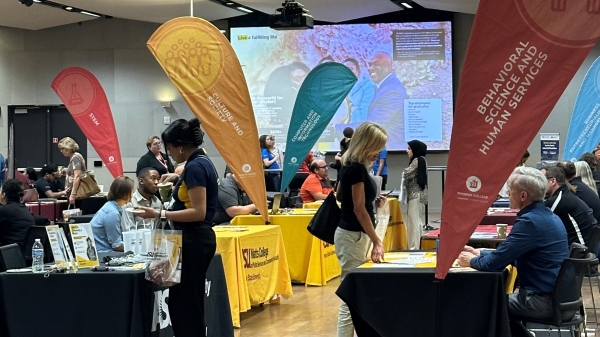ASU Research Enterprise brings Army Mad Scientist conference to Tempe
Growth in megacities — and what that means for military — to be explored

Photo by Peter Szustka
With the strength of nearly half a million fulltime soldiers, the U.S. Army is the largest military branch and has the Herculean task of holding territory to engage adversaries, provide humanitarian relief or conduct any number of missions to advance national interests. Dense urban areas will increasingly be a factor, with 60 percent of the world’s population expected to live in cities by 2030.
This week, Arizona State University Research Enterprise co-hosts a two-day conference with the Army’s Training and Doctrine Command (TRADOC) to explore ideas and concepts for future military operations where megacities may be part of that held territory.
“Adversaries are increasingly moving to environments where U.S. advantages in detection, standoff, and precision firepower may be constrained,” said Joel Lawton, TRADOC intelligence analyst. “The potential for Army involvement within cities may be exacerbated by global challenges, such as liberal trade and economic coordination, climate change, nuclear proliferation, responsibility to protect, and failing states and ungoverned areas.”
Hosted in the Tempe Mission Palms Hotel and Conference Center on April 21-22, the U.S. Army Mad Scientist conference will feature researchers and other prominent speakers exploring topics on megacities.
Mad Scientist — an initiative by TRADOC’s directorate of intelligence — promotes continuous dialogue between joint military, international partners, academia, policy institutions and the private sector to help the Army explore the evolution of future military operational environments.
The ASU Foundation and the ASU Research Enterprise (ASURE) led the organizing of the conference on behalf of the university, demonstrating the institutions’ continued commitment to research of public value and unwavering support for national defense.
“ASURE is very proud to co-host and partner with the U.S. Army on this essential conference,” said Fran Zenzen, ASURE chief operating officer. “ASU is heavily invested in supporting the Department of Defense with a world-class faculty that has the research prowess to help the Army prepare for the future.”
ASU takes a uniquely transdisciplinary approach to research, making it an ideal organization to not only co-host the conference but to also engage productively in the megacities dialogue with the Army.
“First, ASU is and has been deeply involved in urban science, planning and sustainability for over a decade, and we find that the advent of megacities will demand the research capacities we have built,” said Elizabeth “Betsy” Cantwell, vice president for research and development for ASU Knowledge Enterprise Development. “Second, we share the Army’s focal concerns about the global security issues surrounding megacities and dense urban areas, and we believe ASU can and should provide the Army with ideas, innovations and support as they move toward a strategic basis for decision-making.”
An ASU transdisciplinary initiative related to megacities is the Decision Center for a Desert City (DCDC) — a sustainability project established in 2004 by the National Science Foundation that advances scientific understanding of environmental decision making under conditions of uncertainty. In turn, DCDC has produced more than 200 research articles, books and book chapters. It also created WaterSim, a dynamic water-simulation visualization model to estimate water supply and demand.
DCDC is just one example of ASU’s research approach and inquisitiveness fundamental to mutually beneficial collaborations such as Mad Scientist.
Conference attendees will be scientists, futurists, military personnel and members of the ASU community.
More University news

ASU partners on first-of-its-kind $90M NSF research hub for transformational learning, education research
Access to better data leads to better research. When it comes to data about personalized learning, the more researchers know…

ASU Academic Alliances, Maricopa Community Colleges boost student mobility between institutions
The Maricopa Community Colleges stand as one of the leading sources of transfer students to Arizona State University, with ASU…

ASU Project Management Network celebrates 10th anniversary with certification reimbursement
By Widline Luctama Arizona State University's Project Management (PM) Network is celebrating a decade of success in 2024, and it…